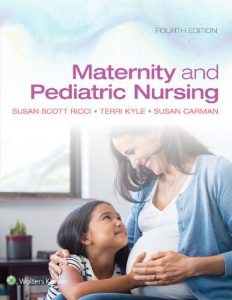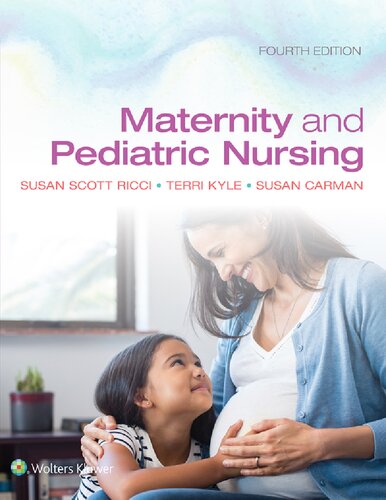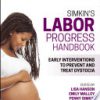Maternity and Pediatric Nursing 4th Edition by Susan Scott Ricci 9781975139780 197513978X
$50.00 Original price was: $50.00.$25.00Current price is: $25.00.
Maternity and Pediatric Nursing 4th Edition Susan Scott Ricci – Ebook Instant Download/Delivery ISBN(s): 9781975139780, 197513978X

Product details:
- ISBN 10: 197513978X
- ISBN 13:9781975139780
- Author: Susan Scott Ricci
Maternity and Pediatric Nursing
Table contents:
CHAPTER 1 Perspectives on Maternal and Child Health Care
Introduction
Historical Development
The History of Maternal and Newborn Health and Health Care
The History of Child Health and Child Health Care
Evolution of Maternal and Newborn Nursing
Evolution of Pediatric Nursing
Health Status of Women and Children
Mortality
Morbidity
Factors Affecting Maternal and Child Health
Family
Genetics
Society
Global Society
Culture
Health Status and Lifestyle
Access to Health Care
Improvements in Diagnosis and Treatments
Empowerment of Health Care Consumers
Barriers to Health Care
Legal and Ethical Issues in Maternal and Child Health Care
Abortion
Substance Abuse
Intrauterine Therapy
Maternal–Fetal Conflict
Stem Cell Research
Umbilical Cord Blood Banking
Informed Consent
Assent
Refusal of Medical Treatment
Advance Directives
Client Rights
Confidentiality
Implications for Nurses
CHAPTER 2 Caring for Women and Children
Introduction
Core Concepts of Maternal and Child Health Nursing
Family-Centered Care
Evidence-Based Care
Collaborative Care
Atraumatic Care
Communication
Education
The Continuum of Care Emphasis
Preventative Care
Culturally Competent Nursing Care
The Nursing Process
Standards of Care and Performance
Community-Based Care
Community Health Nursing
Community-Based Nursing
Shift in Responsibilities from Hospital-Based to Community-Based Nursing
Community-Based Nursing Interventions
Community-Based Nursing Challenges
Community-Based Nursing Care Settings for Women and Children
UNIT II Women’s Health Throughout the Lifespan
CHAPTER 3 Anatomy and Physiology of the Reproductive Systems
Introduction
Female Reproductive Anatomy and Physiology
External Female Reproductive Organs
Internal Female Reproductive Organs
Breasts
Female Sexual Response
The Female Reproductive Cycle
Ovarian Cycle
Endometrial (Uterine) Cycle
Menstruation
Menstrual Cycle Hormones
Perimenopause
Menopause
Male Reproductive Anatomy and Physiology
External Male Reproductive Organs
Internal Male Reproductive Organs
Male Sexual Response
CHAPTER 4 Common Gynecologic Issues
Introduction
Menstrual Disorders
Amenorrhea
Dysmenorrhea
Abnormal Uterine Bleeding (AUB)
Premenstrual Syndrome (PMS)
Endometriosis
Infertility
Cultural Considerations
Etiology and Risk Factors
Therapeutic Management
Nursing Assessment
Nursing Management
Contraception
Types of Contraceptive Methods
Nursing Management for Choosing a Contraceptive Method
Nursing Assessment
Nursing Analyses
Nursing Interventions
Abortion
Surgical Abortion
Medical Abortion
Menopausal Transition
Therapeutic Management
Nursing Assessment
Nursing Management
CHAPTER 5 Sexually Transmitted Infections
Introduction
Sexually Transmitted Infections and Adolescents
Nursing Assessment
Nursing Management
Infections Characterized by Vaginal Discharge
Vaginal Candidiasis (VC)
Therapeutic Management
Nursing Assessment
Nursing Management
Trichomoniasis
Therapeutic Management
Nursing Assessment
Nursing Management
Bacterial Vaginosis (BV)
Therapeutic Management
Nursing Assessment
Nursing Management
Infections Characterized by Cervicitis
Chlamydia
Therapeutic Management
Nursing Assessment
Gonorrhea
Therapeutic Management
Nursing Assessment
Nursing Management of Chlamydia and Gonorrhea
Infections Characterized by Genital Ulcers
Genital Herpes Simplex
Therapeutic Management
Nursing Assessment
Syphilis
Therapeutic Management
Nursing Assessment
Nursing Management of Herpes and Syphilis
Pelvic Inflammatory Disease (PID)
Therapeutic Management
Nursing Assessment
Nursing Management
Vaccine-Preventable STIs
Human Papillomavirus
Nursing Assessment
Therapeutic Management
Nursing Management
Hepatitis A and B
Therapeutic Management
Nursing Assessment
Nursing Management
Hepatitis C
Zika Virus
Ectoparasitic Infections
Human Immunodeficiency Virus (HIV)
HIV and Adolescents
Clinical Manifestations
Diagnosis
Therapeutic Management
Nursing Management
Preventing Sexually Transmitted Infections
Behavior Modification
Contraception
CHAPTER 6 Disorders of the Breasts
Introduction
Benign Breast Disorders
Fibrocystic Breast Changes
Fibroadenomas
Mastitis
Malignant Breast Disorder
Pathophysiology
Staging of Breast Cancer
Risk Factors
Diagnosis
Therapeutic Management
Implementing Health Promotion and Disease Prevention Strategies
Breast Cancer Screening
Nutrition
CHAPTER 7 Benign Disorders of the Female Reproductive Tract
Introduction
Pelvic Floor Disorders
Pelvic Organ Prolapse
Urinary Incontinence
Benign Growths
Polyps
Uterine Fibroids
Genital Fistulas
Bartholin Cysts
Ovarian Cysts
CHAPTER 8 Cancers of the Female Reproductive Tract
Introduction
Ovarian Cancer
Pathophysiology
Screening and Diagnosis
Therapeutic Management
Nursing Assessment
Nursing Management
Endometrial Cancer
Pathophysiology
Screening and Diagnosis
Therapeutic Management
Nursing Assessment
Nursing Management
Cervical Cancer
Pathophysiology
Screening and Diagnosis
Therapeutic Management
Nursing Assessment
Nursing Management
Vaginal Cancer
Pathophysiology
Therapeutic Management
Nursing Assessment
Nursing Management
Vulvar Cancer
Pathophysiology
Screening and Diagnosis
Therapeutic Management
Nursing Assessment
Nursing Management
CHAPTER 9 Violence and Abuse
Introduction
Intimate Partner Violence
Incidence
Background
Characteristics of Intimate Partner Violence
Types of Abuse
Myths and Facts about Intimate Partner Violence
Abuse Profiles
Violence against Pregnant Women
Violence against Older Women
Nursing Management of Intimate Partner Violence Victims
Sexual Violence
Characteristics of Assailants
Sexual Abuse
Incest
Rape
Female Genital Cutting
Human Trafficking
Summary
UNIT III Pregnancy
CHAPTER 10 Fetal Development and Genetics
Introduction
Fetal Development
Zygotic Stage
Blastocyst Stage
Embryonic Stage
Fetal Stage
Fetal Circulation
Genetics
Advances in Genetics
Inheritance
Patterns of Inheritance for Genetic Disorders
Chromosomal Abnormalities
Genetic Evaluation and Counseling
Nursing Roles and Responsibilities
CHAPTER 11 Maternal Adaptation During Pregnancy
Introduction
Signs and Symptoms of Pregnancy
Subjective (Presumptive) Signs
Objective (Probable) Signs
Positive Signs
Physiologic Adaptations During Pregnancy
Reproductive System Adaptations
General Body System Adaptations
Changing Nutritional Needs of Pregnancy
Nutritional Requirements During Pregnancy
Gluten-Free Diet During Pregnancy
USDA and MyPlate
Maternal Weight Gain
Nutrition Promotion
Special Nutritional Considerations
Psychosocial Adaptations During Pregnancy
Maternal Emotional Responses
Becoming a Mother
Pregnancy and Sexuality
Pregnancy and the Partner
Pregnancy and Siblings
CHAPTER 12 Nursing Management During Pregnancy
Introduction
Preconception and Interconception Care
Risk Factors for Adverse Pregnancy Outcomes
Nursing Management
The First Prenatal Visit
Comprehensive Health History
Physical Examination
Laboratory Tests
Follow-Up Visits
Follow-Up Visit Intervals and Assessments
Fundal Height Measurement
Fetal Movement Determination
Fetal Heart Rate Measurement
Teaching about the Danger Signs during Pregnancy
Assessment of Fetal Well-Being
Ultrasonography
Doppler Flow Studies
Alpha-Fetoprotein Analysis
Marker Screening Tests
Nuchal Translucency Screening
Amniocentesis
Chorionic Villus Sampling
Nonstress Test
Biophysical Profile
Nursing Management for the Common Discomforts of Pregnancy
First-Trimester Discomforts
Second-Trimester Discomforts
Third-Trimester Discomforts
Nursing Management to Promote Self-Care
Personal Hygiene
Clothing
Exercise
Sleep and Rest
Sexual Activity and Sexuality
Employment
Travel
Immunizations and Medications
Nursing Management to Prepare the Woman and Her Partner for Labor, Birth, and Parenthood
Childbirth Education Classes
Nursing Management and Childbirth Education
Options for Birth Settings and Care Providers
Preparation for Breastfeeding or Bottle-Feeding
Final Preparation for Labor and Birth
UNIT IV Labor and Birth
CHAPTER 13 Labor and Birth Process
Introduction
Initiation of Labor
Premonitory Signs of Labor
Cervical Changes
Lightening
Increased Energy Level
Bloody Show
Braxton Hicks Contractions
Spontaneous Rupture of Membranes
True Versus False Labor
Factors Affecting the Labor Process
Passageway
Passenger
Powers
Position (Maternal)
Psychological Response
Philosophy
Partners
Patience
Patient (Client) Preparation: Prenatal Education
Pain Management
Physiologic Responses to Labor
Maternal Responses
Fetal Responses
Stages of Labor
First Stage
Second Stage
Third Stage
Fourth Stage
CHAPTER 14 Nursing Management During Labor and Birth
Introduction
Maternal Assessment During Labor and Birth
Vaginal Examination
Assessing Uterine Contractions
Performing Leopold Maneuvers
Fetal Assessment During Labor and Birth
Analysis of Amniotic Fluid
Analysis of the FHR
Other Fetal Assessment Methods
Promoting Comfort and Providing Pain Management During Labor
Nonpharmacologic Measures
Pharmacologic Measures
Nursing Care During Labor and Birth
Nursing Management during the First Stage of Labor
Nursing Management during the Second Stage of Labor
Nursing Management during the Third Stage of Labor
Nursing Management during the Fourth Stage of Labor
UNIT V Postpartum Period
CHAPTER 15 Postpartum Adaptations
Introduction
Maternal Physiologic Adaptations
Reproductive System Adaptations
Cardiovascular System Adaptations
Urinary System Adaptations
Gastrointestinal System Adaptations
Musculoskeletal System Adaptations
Integumentary System Adaptations
Respiratory System Adaptations
Endocrine System Adaptations
Weight Loss after Childbirth
Sexual Health
Global Health of Childbearing Women
Lactation
Ovulation and Return of Menstruation
Cultural Considerations for the Postpartum Period
Balance of Hot and Cold
Postpartum Cultural Beliefs
Psychological Adaptations
Parental Attachment Behaviors
Maternal Psychological Adaptations
Partner Psychological Adaptations
CHAPTER 16 Nursing Management During the Postpartum Period
Introduction
Social Support and Cultural Considerations
Nursing Assessment in the Postpartum Period
Vital Signs Assessment
Physical Examination
Psychosocial Assessment
Nursing Interventions
Providing Optimal Cultural Care
Promoting Comfort
Assisting with Elimination
Promoting Activity, Rest, and Exercise
Preventing Stress Incontinence
Assisting with Self-Care Measures
Ensuring Safety
Counseling about Sexuality and Contraception
Promoting Maternal Nutrition
Supporting the Woman’s Choice of Infant Feeding Method
Teaching about Breast Care
Promoting Family Adjustment and Well-Being
Preparing for Discharge
UNIT VI The Newborn
CHAPTER 17 Newborn Transitioning
Introduction
Physiologic Transitioning
Cardiovascular System Adaptations
Respiratory System Adaptations
Body Temperature Regulation
Hepatic System Function
Gastrointestinal System Adaptations
Renal System Changes
Immune System Adaptations
Integumentary System Adaptations
Neurologic System Adaptations
Behavioral Adaptations
Behavioral Patterns
Behavioral Responses
CHAPTER 18 Nursing Management of the Newborn
Introduction
Nursing Management During the Immediate Newborn Period
Assessment
Nursing Interventions
Nursing Management During the Early Newborn Period
Assessment
Nursing Interventions
UNIT VII Childbearing at Risk
CHAPTER 19 Nursing Management of Pregnancy at Risk: Pregnancy-Related Complications
Introduction
Bleeding During Pregnancy
Spontaneous Abortion
Ectopic Pregnancy
Gestational Trophoblastic Disease
Cervical Insufficiency
Placenta Previa
Placental Abruption
Placenta Accreta Spectrum
Hyperemesis Gravidarum
Pathophysiology
Therapeutic Management
Nursing Assessment
Nursing Management
Hypertensive Disorders of Pregnancy
Chronic Hypertension
Gestational Hypertension
Preeclampsia/Eclampsia
HELLP Syndrome
Gestational Diabetes
Blood Incompatibility
Pathophysiology
Nursing Assessment
Nursing Management
Amniotic Fluid Imbalances
Polyhydramnios
Oligohydramnios
Multiple Gestation
Therapeutic Management
Nursing Assessment
Nursing Management
Prelabor Rupture of Membranes
Therapeutic Management
Nursing Assessment
Nursing Management
CHAPTER 20 Nursing Management of the Pregnancy at Risk: Selected Health Conditions and Vulnerable Populations
Introduction
Diabetes Mellitus
Pathophysiology
Screening
Therapeutic Management
Nursing Assessment
Nursing Management
Cardiovascular Disorders
Congenital and Acquired Heart Disease
Hypertension in Pregnancy
Chronic Hypertension
Respiratory Conditions
Asthma
Tuberculosis
Hematologic Conditions
Iron-Deficiency Anemia
Thalassemia
Sickle Cell Anemia
Autoimmune Disorders
Systemic Lupus Erythematosus
Multiple Sclerosis
Rheumatoid Arthritis
Infections
Cytomegalovirus
Rubella
Herpes Simplex Virus
Hepatitis B Virus
Varicella Zoster Virus
Parvovirus B19
Group B Streptococcus
Toxoplasmosis
Women Who Are HIV-Positive
Vulnerable Populations
Pregnant Adolescents
The Woman of Advanced Maternal Age
The Obese Pregnant Woman
The Pregnant Woman and Substance Abuse
CHAPTER 21 Nursing Management of Labor and Birth at Risk
Introduction
Dystocia
Problems with the Powers
Problems with the Passenger
Problems with the Passageway
Problems with the Psyche
Nursing Assessment
Nursing Management
Nontraditional Families
Preterm Labor
Therapeutic Management
Nursing Assessment
Nursing Management
Post-Term Pregnancy
Nursing Assessment
Nursing Management
Women Requiring Labor Induction and Augmentation
Therapeutic Management
Nursing Assessment
Nursing Management
Vaginal Birth after Cesarean
Intrauterine Fetal Demise
Nursing Assessment
Nursing Management
Women Experiencing an Obstetric Emergency
Umbilical Cord Prolapse
Placenta Previa
Placental Abruption
Uterine Rupture
Anaphylactoid Syndrome of Pregnancy
Women Requiring Birth-Related Procedures
Forceps- or Vacuum-Assisted Birth
Cesarean Birth
CHAPTER 22 Nursing Management of the Postpartum Woman at Risk
Introduction
Postpartum Hemorrhage
Pathophysiology
Nursing Assessment
Nursing Management
Venous Thromboembolic Conditions
Pathophysiology
Nursing Assessment
Nursing Management
Postpartum Infection
Endometritis
Surgical Site Infections
Urinary Tract Infections
Mastitis
Postpartum Affective Disorders
Postpartum Blues
Postpartum Depression
Postpartum Psychosis
UNIT VIII The Newborn at Risk
CHAPTER 23 Nursing Care of the Newborn with Special Needs
Introduction
Birth Weight Variations
Small-for-Gestational-Age Newborns
Large-for-Gestational-Age Newborns
Gestational Age Variations
Postterm Newborn
Preterm Newborn
Late Preterm Newborn (“Near Term”)
Dealing with Perinatal Loss
CHAPTER 24 Nursing Management of the Newborn at Risk: Acquired and Congenital Newborn Conditions
Introduction
Acquired Disorders
Hypoxic-Ischemic Encephalopathy
Transient Tachypnea of the Newborn
Respiratory Distress Syndrome
Meconium Aspiration Syndrome (MAS)
Persistent Pulmonary Hypertension of the Newborn
Periventricular-Intraventricular Hemorrhage (PIVH)
Necrotizing Enterocolitis
Infants of Diabetic Mothers (IDM)
Birth Injuries
Newborns of Mothers with Substance Use Disorder (SUD)
Hyperbilirubinemia
Congenital Conditions
Esophageal Atresia and Tracheoesophageal Fistula
Omphalocele and Gastroschisis
Anorectal Malformations
Bladder Exstrophy
UNIT IX Health Promotion of the Growing Child and Family
CHAPTER 25 Growth and Development of the Newborn and Infant
Introduction
Physical Growth
Weight
Length
Head Circumference
Physiologic Changes
Neurologic System
Respiratory System
Cardiovascular System
Gastrointestinal System
Genitourinary System
Integumentary System
Hematopoietic System
Immunologic System
Psychosocial Development
Cognitive Development
Motor Skill Development
Gross Motor Skills
Fine Motor Skills
Sensory Development
Sight
Hearing
Smell and Taste
Touch
Communication and Language Development
Social and Emotional Development
Stranger Anxiety
Separation Anxiety
Temperament
Cultural Influences on Growth and Development
Promoting Healthy Growth and Development
Promoting Growth and Development Through Play
Promoting Early Learning
Promoting Safety
Promoting Nutrition
Promoting Healthy Sleep and Rest
Promoting Healthy Teeth and Gums
Promoting Appropriate Discipline
Addressing Child Care Needs
Addressing Common Developmental Concerns
Colic
Spitting Up
Thumb Sucking, Pacifiers, and Security Items
Teething
CHAPTER 26 Growth and Development of the Toddler
Introduction
Physical Growth
Physiologic Changes
Neurologic System
Respiratory System
Cardiovascular System
Gastrointestinal System
Genitourinary System
Musculoskeletal System
Psychosocial Development
Cognitive Development
Motor Skill Development
Gross Motor Skills
Fine Motor Skills
Sensory Development
Communication and Language Development
Emotional and Social Development
Separation Anxiety
Temperament
Fears
Moral and Spiritual Development
Cultural Influences on Growth and Development
The Nurse’S Role in Toddler Growth and Development
Promoting Healthy Growth and Development
Promoting Growth and Development Through Play
Promoting Early Learning
Promoting Safety
Promoting Nutrition
Promoting Healthy Sleep and Rest
Promoting Healthy Teeth and Gums
Promoting Appropriate Discipline
Addressing Common Developmental Concerns
Toilet Teaching
Negativism
Temper Tantrums
Thumb Sucking and Pacifiers
Sibling Rivalry
Regression
CHAPTER 27 Growth and Development of the Preschooler
Introduction
Physical Growth
Physiologic Changes
Psychosocial Development
Cognitive Development
Moral and Spiritual Development
Motor Skill Development
Gross Motor Skills
Fine Motor Skills
Sensory Development
Communication and Language Development
Emotional and Social Development
Friendships
Temperament
Fears
Cultural Influences on Growth and Development
Promoting Healthy Growth and Development
Promoting Growth and Development Through Play
Promoting Early Learning
Promoting Language Development
Choosing a Preschool/Starting Kindergarten
Promoting Safety
Safety in the Water
Promoting Nutrition
Promoting Healthy Sleep and Rest
Promoting Healthy Teeth and Gums
Promoting Appropriate Discipline
Addressing Common Developmental Concerns
Lying
Sex Education
Masturbation
CHAPTER 28 Growth and Development of the School-Age Child
Introduction
Physical Growth
Physiologic Changes
Neurologic System
Respiratory System
Cardiovascular System
Gastrointestinal System
Genitourinary System
Prepubescence
Musculoskeletal System
Immune System
Psychosocial Development
Cognitive Development
Moral and Spiritual Development
Motor Skill Development
Gross Motor Skills
Fine Motor Skills
Sensory Development
Communication and Language Development
Emotional and Social Development
Temperament
Self-Esteem Development
Body Image
School-Age Fears
Peer Relationships
Teacher and School Influences
Family Influences
Cultural Influences on Growth and Development
The Nurse’S Role in School-Age Growth and Development
Promoting Healthy Growth and Development
Promoting Growth and Development Through Play
Promoting Learning
Promoting Safety
Abuse in Children
Promoting Nutrition
Promoting Healthy Sleep and Rest
Promoting Healthy Teeth and Gums
Promoting Appropriate Discipline
Addressing Common Developmental Concerns
Television, Video Games, and the Internet
School Refusal
Latchkey Children
Stealing, Lying, and Cheating
Bullying
Tobacco and Alcohol Education
CHAPTER 29 Growth and Development of the Adolescent
Introduction
Physiologic Changes Associated with Puberty
Physical Growth
Physiologic Changes
Neurologic System
Respiratory System
Cardiovascular System
Gastrointestinal System
Musculoskeletal System
Integumentary System
Psychosocial Development
Cognitive Development
Moral and Spiritual Development
Motor Skill Development
Gross Motor Skills
Fine Motor Skills
Communication and Language Development
Emotional and Social Development
Relationship with Parents
Self-Concept and Body Image
Importance of Peers
Sexuality
Dating
Cultural Influences on Growth and Development
The Nurse’S Role in Adolescent Growth and Development
Promoting Healthy Growth and Development
Promoting Growth and Development Through Sports and Physical Fitness
Promoting Learning
Promoting Safety
Promoting Nutrition
Promoting Healthy Sleep and Rest
Promoting Healthy Teeth and Gums
Promoting Personal Care
Promoting Appropriate Discipline
Promoting Proper Media Use
Addressing Common Developmental Concerns
Violence
Substance Use
UNIT X Foundations of Pediatric Nursing
CHAPTER 30 Atraumatic Care of Children and Families
Introduction
Preventing/Minimizing Physical Stressors
Utilizing the Child Life Specialist
Minimizing Physical Stress During Procedures
Preventing or Minimizing Child and Family Separation: Providing Child- and Family-Centered Care
Promoting a Sense of Control
Enhancing Communication
Teaching Children and Families
CHAPTER 31 Health Supervision
Principles of Health Supervision
Wellness
Medical Home
Partnerships
Special Issues in Health Supervision
Components of Health Supervision
Developmental Surveillance and Screening
Injury and Disease Prevention
Health Promotion
CHAPTER 32 Health Assessment of Children
Introduction
Health History
Preparing for the Health History
Performing a Health History
Physical Examination
Preparing for the Physical Examination
Steps of the Physical Examination
Performing a Physical Examination
CHAPTER 33 Caring for Children in Diverse Settings
Introduction
Community Health Nursing
Community-Based Nursing
Shifting Responsibilities from Hospital to Community-Based Nursing Care
Role of the Community-Based Nurse
Illness and Hospitalization in Childhood
General Inpatient Unit
Emergency Departments
Pediatric Intensive Care Units
Rehabilitation Units/Facilities
Outpatient Facilities
Physician’s Office or Clinic, Health Departments, and Urgent Care Centers
Medically Fragile Day Care Centers
Schools
Home Health Care
Other Community Settings
Children’s Reactions to Illness and Hospitalization
Anxiety and Fear
Separation Anxiety
Loss of Control
Factors Affecting Children’s Reaction to Illness and Hospitalization
Developmental Level
Previous Experiences
Recent Stresses and Changes and Individual Coping Skills
Parents’ Response to Child’s Illness and Hospitalization
Family’s Reactions to the Child’s Illness and Hospitalization
Reactions of Parents
Reactions of Siblings
Factors Influencing Family Reactions
Preparing the Child and Family for Surgery
Providing Preoperative Teaching
Safety During Hospitalization or Procedures
Maintaining the Child’s Safety
Use of Restraints
Transport of the Child
Hospitalization in Childhood
Preparing Children and Families for Hospitalization
Admitting the Child to the Facility
Addressing the Effects of Hospitalization Developmentally
Providing Basic Care for the Hospitalized Child
Providing Play, Activities, and Recreation for the Hospitalized Child
Promoting Schoolwork and Education During Hospitalization
Family Members’ Needs
Child and Family Teaching
CHAPTER 34 Caring for the Special Needs Child
Introduction
The Medically Fragile Child
Impact of the Problem
Effects of Special Needs on the Child
Effects on the Family
Nursing Management of the Medically Fragile Child and Family
The Dying Child
End-of-Life Decision-Making
Nursing Management of the Dying Child
CHAPTER 35 Key Pediatric Nursing Interventions
Introduction
Medication Administration
Differences in Pharmacodynamics and Pharmacokinetics
Developmental Issues and Concerns
Determination of Correct Dose
Oral Administration
Rectal Administration
Ophthalmic Administration
Otic Administration
Nasal Administration
Intramuscular Administration
Subcutaneous and Intradermal Administration
Intravenous Administration
Providing Atraumatic Care
Educating the Child and Parents
Preventing Medication Errors
Intravenous Therapy
Sites
Equipment
Inserting Peripheral IV Access Devices
IV Fluid Administration
Preventing Complications
Discontinuing the IV Device
Providing Nutritional Support
Enteral Nutrition
Parenteral Nutrition
CHAPTER 36 Nursing Care of the Child with an Alteration in Comfort–Pain Assessment and Management
Introduction
Physiology of Pain
Transduction
Transmission
Perception
Modulation
Types of Pain
Classification by Duration
Classification by Etiology
Classification by Source or Location
Factors Influencing Pain
Age and Gender
Cognitive Level
Temperament
Previous Pain Experiences
Family and Culture
Situational Factors
Developmental Considerations
Infants
Toddlers
Preschoolers
School-Age Children
Adolescents
Common Fallacies and Myths About Pain in Children
Management of Pain
Nonpharmacologic Management
Pharmacologic Management
Management of Procedure-Related Pain
Management of Chronic Pain
UNIT XI Nursing Care of the Child with a Health Disorder
CHAPTER 37 Nursing Care of the Child with an Infection
Introduction
Infectious Process
Fever
Stages of Infectious Disease
Chain of Infection
Preventing the Spread of Infection
Variations in Pediatric Anatomy and Physiology
Common Medical Treatments
Sepsis
Bacterial Infections
Community-Acquired Methicillin-Resistant Staphylococcus Aureus
Scarlet Fever
Diphtheria
Pertussis
Tetanus
Botulism
Osteomyelitis
Septic Arthritis
Viral Infections
Viral Exanthems
Mumps
Zoonotic Infections
Cat-Scratch Disease
Rabies
Lyme Disease
Rocky Mountain Spotted Fever
Parasitic and Helminthic Infection
Sexually Transmitted Infections
CHAPTER 38 Nursing Care of the Child with an Alteration in Intracranial Regulation/Neurologic Disorder
Introduction
Variations in Pediatric Anatomy and Physiology
Brain and Spinal Cord Development
Nervous System
Head Size
Common Medical Treatments
Seizure Disorders
Epilepsy
Febrile Seizures
Neonatal Seizures
Structural Defects
Neural Tube Defects
Anencephaly
Encephalocele
Microcephaly
Chiari Malformation
Hydrocephalus
Intracranial Arteriovenous Malformation
Craniosynostosis
Positional Plagiocephaly
Infectious Disorders
Bacterial Meningitis
Aseptic Meningitis
Encephalitis
Reye Syndrome
Trauma
Head Trauma
Nonaccidental Head Trauma
Near-Drowning
Blood Flow Disruption
Cerebral Vascular Disorders (Stroke)
Chronic Disorders
Headaches
Breath Holding
CHAPTER 39 Nursing Care of the Child with an Alteration in Sensory Perception/Disorder of the Eyes or Ears
Introduction
Variations in Pediatric Anatomy and Physiology
Eyes
Ears
Common Medical Treatments
Infectious and Inflammatory Disorders of the Eyes
Conjunctivitis
Nasolacrimal Duct Obstruction
Eyelid Disorders
Eye Injuries
Visual Disorders
Refractive Errors
Strabismus
Amblyopia
Nystagmus
Infantile Glaucoma
Congenital Cataract
Retinopathy of Prematurity
Visual Impairment
Infectious and Inflammatory Disorders of the Ears
Acute Otitis Media
Otitis Media with Effusion
Otitis Externa
Hearing Loss and Deafness
CHAPTER 40 Nursing Care of the Child with an Alteration in Gas Exchange/Respiratory Disorder
Introduction
Variations in Pediatric Anatomy and Physiology
Nose
Throat
Trachea
Lower Respiratory Structures
Chest Wall
Metabolic Rate and Oxygen Need
Common Medical Treatments
Acute Infectious Disorders
Common Cold
Sinusitis
Influenza
Pharyngitis
Tonsillitis
Infectious Mononucleosis
Laryngitis
Croup
Epiglottitis
Bronchiolitis
Pneumonia
Bronchitis
Tuberculosis
Acute Noninfectious Disorders
Epistaxis
Foreign Body Aspiration
Acute Respiratory Distress Syndrome
Pneumothorax
Chronic Respiratory Disorders
Allergic Rhinitis
Asthma
Chronic Lung Disease
Cystic Fibrosis
Apnea
Tracheostomy
CHAPTER 41 Nursing Care of the Child with an Alteration in Perfusion/Cardiovascular Disorder
Introduction
Variations in Pediatric Anatomy and Physiology
Circulatory Changes from Gestation to Birth
Structural and Functional Differences
Common Medical Treatments
Cardiac Catheterization
Cardiac Catheterization
Congenital Heart Disease
Disorders with Decreased Pulmonary Blood Flow
Tetralogy of Fallot
Tricuspid Atresia
Disorders with Increased Pulmonary Flow
Atrial Septal Defect
Ventricular Septal Defect
Atrioventricular Canal Defect
Patent Ductus Arteriosus
Obstructive Disorders
Coarctation of the Aorta
Aortic Stenosis
Pulmonary Stenosis
Mixed Defects
Transposition of the Great Vessels (Arteries)
Total Anomalous Pulmonary Venous Connection
Truncus Arteriosus
Hypoplastic Left Heart Syndrome
Acquired Cardiovascular Disorders
Heart Failure
Infective Endocarditis
Acute Rheumatic Fever
Cardiomyopathy
Hypertension
Kawasaki Disease
Dyslipidemia
Heart Transplantation
Surgical Procedure and Postoperative Therapeutic Management
CHAPTER 42 Nursing Care of the Child with an Alteration in Bowel Elimination/Gastrointestinal Disorder
Introduction
Variations in Pediatric Anatomy and Physiology
Mouth
Esophagus
Stomach
Intestines
Biliary System
Fluid Balance and Losses
Common Medical Treatments
Stool Diversions
Structural Anomalies of the Gastrointestinal Tract
Cleft Lip and Palate
Meckel Diverticulum
Inguinal and Umbilical Hernias
Inguinal Hernia
Umbilical Hernia
Acute Gastrointestinal Disorders
Dehydration
Vomiting
Diarrhea
Oral Candidiasis (Thrush)
Oral Lesions
Hypertrophic Pyloric Stenosis
Intussusception
Malrotation and Volvulus
Appendicitis
Chronic Gastrointestinal Disorders
Gastroesophageal Reflux Disease
Peptic Ulcer Disease
Constipation and Encopresis
Hirschsprung Disease (Congenital Aganglionic Megacolon)
Short Bowel Syndrome
Inflammatory Bowel Disease
Celiac Disease
Functional Abdominal Pain
Hepatobiliary Disorders
Pancreatitis
Gallbladder Disease
Biliary Atresia
Hepatitis
Cirrhosis and Portal Hypertension
Liver Transplantation
CHAPTER 43 Nursing Care of the Child with an Alteration in Urinary Elimination/Genitourinary Disorder
Introduction
Variations in Pediatric Anatomy and Physiology
Structural Differences
Urinary Concentration
Urine Output
Reproductive Organ Maturity
Common Medical Treatments
Collecting Urine Specimens in Children
Urinary Tract and Renal Disorders
Structural Disorders
Hypospadias/Epispadias
Obstructive Uropathy
Hydronephrosis
Vesicoureteral Reflux
Urinary Disorders
Urinary Tract Infection
Enuresis
Acquired Disorders Resulting in Altered Renal Function
Nephrotic Syndrome
Acute Poststreptococcal Glomerulonephritis
Hemolytic Uremic Syndrome
Renal Failure
Acute Renal Failure
End-Stage Renal Disease
Dialysis and Transplantation
Peritoneal Dialysis
Hemodialysis
Renal Transplantation
Reproductive Organ Disorders
Female Disorders
Labial Adhesions
Vulvovaginitis
Male Disorders
Phimosis and Paraphimosis
Circumcision
Cryptorchidism
Hydrocele and Varicocele
Testicular Torsion
Epididymitis
CHAPTER 44 Nursing Care of the Child with an Alteration in Mobility/Neuromuscular or Musculoskeletal Disorder
Introduction
Variations in Pediatric Anatomy and Physiology
Brain and Spinal Cord Development
Myelinization
Muscular Development
Skeletal Development
Common Medical Treatments
Casts
Traction
External Fixation
Congenital and Developmental Disorders
Neural Tube Defects
Spina Bifida Occulta
Meningocele
Myelomeningocele
Pectus Excavatum
Limb Deficiencies
Polydactyly/Syndactyly
Metatarsus Adductus
Congenital Clubfoot
Osteogenesis Imperfecta
Developmental Dysplasia of the Hip
Torticollis
Tibia Vara (Blount Disease)
Muscular Dystrophy
Spinal Muscular Atrophy
Cerebral Palsy
Acquired Disorders
Rickets
Slipped Capital Femoral Epiphysis
Legg–Calvé–Perthes Disease
Transient Synovitis of the Hip
Scoliosis
Spinal Cord Injury
Fracture
Sprains
Overuse Syndromes
Radial Head Subluxation
CHAPTER 45 Nursing Care of the Child with an Alteration in Tissue Integrity/Integumentary Disorder
Introduction
Variations in Pediatric Anatomy and Physiology
Differences in the Skin between Children and Adults
Common Medical Treatments
Infectious Disorders
Bacterial Infections
Fungal Infections
Inflammatory Skin Conditions
Diaper Dermatitis
Atopic Dermatitis
Contact Dermatitis
Erythema Multiforme
Urticaria
Seborrhea
Psoriasis
Acne
Acne Neonatorum
Acne Vulgaris
Injuries
Pressure Ulcers
Minor Injuries
Burns
Sunburn
Cold Injury
Human and Animal Bites
Insect Stings and Spider Bites
CHAPTER 46 Nursing Care of the Child with an Alteration in Cellular Regulation/Hematologic or Neoplastic Disorder
Introduction
Variations in Pediatric Anatomy and Physiology
Red Blood Cell Production
Hemoglobin
Iron
Childhood Cancer versus Adult Cancer
Common Medical Treatments
Chemotherapy
Radiation Therapy
Hematopoietic Stem Cell Transplantation
Palliative Care
Laboratory and Diagnostic Testing
Caring for the Child with Cancer
Anemia
Iron-Deficiency Anemia
Other Nutritional Causes of Anemia
Lead Poisoning
Aplastic Anemia
Hemoglobinopathies
Sickle Cell Disease
Thalassemia
Glucose-6-Phosphate Dehydrogenase Deficiency
Clotting Disorders
Idiopathic Thrombocytopenia Purpura
Henoch–Schönlein Purpura
Disseminated Intravascular Coagulation
Hemophilia
Von Willebrand Disease
Leukemia
Acute Lymphoblastic Leukemia
Acute Myelogenous Leukemia
Lymphomas
Hodgkin Disease
Non-Hodgkin Lymphoma
Brain Tumors
Neuroblastoma
Sarcomas
Osteosarcoma
Ewing Sarcoma
Rhabdomyosarcoma
Wilms Tumor
Retinoblastoma
Screening for Reproductive Cancers in Adolescents
Cervical Cancer
Testicular Cancer
CHAPTER 47 Nursing Care of the Child with an Alteration in Immunity or Immunologic Disorder
Introduction
Variations in Pediatric Anatomy and Physiology
Lymph System
Phagocytosis
Cellular Immunity
Humoral Immunity
Common Medical Treatments
Primary Immunodeficiencies
Hypogammaglobulinemia
Wiskott–Aldrich Syndrome
Severe Combined Immune Deficiency
Secondary Immunodeficiencies
HIV Infection
Autoimmune Disorders
Systemic Lupus Erythematosus
Juvenile Idiopathic Arthritis
Guillain–Barré Syndrome
Myasthenia Gravis
Dermatomyositis
Allergy and Anaphylaxis
Food Allergies
Anaphylaxis
Latex Allergy
CHAPTER 48 Nursing Care of the Child with an Alteration in Metabolism/Endocrine Disorder
Introduction
Variations in Anatomy and Physiology
Hormone Production and Secretion
Common Medical Treatments
Pituitary Disorders
Growth Hormone Deficiency
Precocious Puberty
Delayed Puberty
Diabetes Insipidus
Syndrome of Inappropriate Antidiuretic Hormone
Disorders of Thyroid Function
Congenital Hypothyroidism
Acquired Hypothyroidism
Hyperthyroidism
Disorders Related to Parathyroid Gland Function
Disorders Related to Adrenal Gland Function
Congenital Adrenal Hyperplasia
Polycystic Ovary Syndrome
Diabetes Mellitus
CHAPTER 49 Nursing Care of the Child with an Alteration in Genetics
Introduction
Nurse’s Role and Responsibilities
Common Medical Treatments
Common Chromosomal Abnormalities
Trisomy 21 (Down Syndrome)
Trisomy 18 and Trisomy 13
Turner Syndrome
Klinefelter Syndrome
Fragile X Syndrome
Neurocutaneous Disorders
Neurofibromatosis
Other Genetic Disorders
Inborn Errors of Metabolism
CHAPTER 50 Nursing Care of the Child with an Alteration in Behavior, Cognition, or Development
Introduction
Effects of Mental Health Issues on Health and Development
Common Medical Treatments
Developmental and Behavioral Disorders
Learning Disabilities
Intellectual Disability
Autism Spectrum Disorder
Attention-Deficit/Hyperactivity Disorder
Tourette Syndrome
Eating Disorders
Mood Disorders
Anxiety Disorders
Types of Anxiety Disorders
Abuse and Violence
Child Maltreatment
Medical Child Abuse
Substance Abuse
CHAPTER 51 Nursing Care During a Pediatric Emergency
Introduction
Common Medical Treatments
Nursing Management of Children in Emergencies
Respiratory Arrest
Shock
People also search:
maternity and pediatric nursing
maternity and pediatric nursing 4th edition pdf free
introduction to maternity and pediatric nursing
maternity and pediatric nursing 4th edition quizlet
canadian maternity and pediatric nursing
You may also like…
Medicine - Medicine & Nursing Reference
Medicine - Pediatrics
Canadian Maternity and Pediatric Nursing 2nd Edition Jessica Webster
Jurisprudence & Law - Legal Theory & Philosophy
Medicine
Mental Health Strategies for Pediatric Care 1st Edition by Susan G. Forman 9781610025485 1610025482
Medicine - Nursing
Writing for Nursing and Midwifery Students 4th Edition Julio Gimenez
Medicine - Dentistry
Medicine - Medicine & Nursing Reference
Nursing Informatics for the Advanced Practice Nurse 3rd Edition Susan Mcbride
Medicine - Ophthalmology
Pediatric ophthalmology for primary care 4th Edition Kenneth Weston Wright












